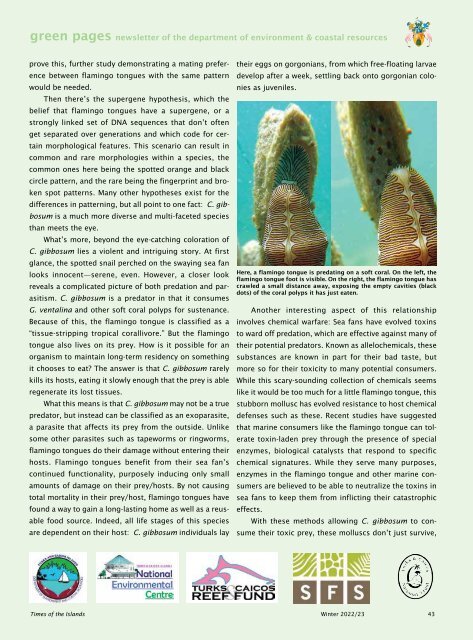Times of the Islands Winter 2022/23
Presents the "soul of the Turks & Caicos Islands" with in-depth features about local people, culture, history, environment, real estate, businesses, resorts, restaurants and activities.
Presents the "soul of the Turks & Caicos Islands" with in-depth features about local people, culture, history, environment, real estate, businesses, resorts, restaurants and activities.
- No tags were found...
You also want an ePaper? Increase the reach of your titles
YUMPU automatically turns print PDFs into web optimized ePapers that Google loves.
green pages newsletter <strong>of</strong> <strong>the</strong> department <strong>of</strong> environment & coastal resources<br />
prove this, fur<strong>the</strong>r study demonstrating a mating preference<br />
between flamingo tongues with <strong>the</strong> same pattern<br />
would be needed.<br />
Then <strong>the</strong>re’s <strong>the</strong> supergene hypo<strong>the</strong>sis, which <strong>the</strong><br />
belief that flamingo tongues have a supergene, or a<br />
strongly linked set <strong>of</strong> DNA sequences that don’t <strong>of</strong>ten<br />
get separated over generations and which code for certain<br />
morphological features. This scenario can result in<br />
common and rare morphologies within a species, <strong>the</strong><br />
common ones here being <strong>the</strong> spotted orange and black<br />
circle pattern, and <strong>the</strong> rare being <strong>the</strong> fingerprint and broken<br />
spot patterns. Many o<strong>the</strong>r hypo<strong>the</strong>ses exist for <strong>the</strong><br />
differences in patterning, but all point to one fact: C. gibbosum<br />
is a much more diverse and multi-faceted species<br />
than meets <strong>the</strong> eye.<br />
What’s more, beyond <strong>the</strong> eye-catching coloration <strong>of</strong><br />
C. gibbosum lies a violent and intriguing story. At first<br />
glance, <strong>the</strong> spotted snail perched on <strong>the</strong> swaying sea fan<br />
looks innocent—serene, even. However, a closer look<br />
reveals a complicated picture <strong>of</strong> both predation and parasitism.<br />
C. gibbosum is a predator in that it consumes<br />
G. ventalina and o<strong>the</strong>r s<strong>of</strong>t coral polyps for sustenance.<br />
Because <strong>of</strong> this, <strong>the</strong> flamingo tongue is classified as a<br />
“tissue-stripping tropical corallivore.” But <strong>the</strong> flamingo<br />
tongue also lives on its prey. How is it possible for an<br />
organism to maintain long-term residency on something<br />
it chooses to eat? The answer is that C. gibbosum rarely<br />
kills its hosts, eating it slowly enough that <strong>the</strong> prey is able<br />
regenerate its lost tissues.<br />
What this means is that C. gibbosum may not be a true<br />
predator, but instead can be classified as an exoparasite,<br />
a parasite that affects its prey from <strong>the</strong> outside. Unlike<br />
some o<strong>the</strong>r parasites such as tapeworms or ringworms,<br />
flamingo tongues do <strong>the</strong>ir damage without entering <strong>the</strong>ir<br />
hosts. Flamingo tongues benefit from <strong>the</strong>ir sea fan’s<br />
continued functionality, purposely inducing only small<br />
amounts <strong>of</strong> damage on <strong>the</strong>ir prey/hosts. By not causing<br />
total mortality in <strong>the</strong>ir prey/host, flamingo tongues have<br />
found a way to gain a long-lasting home as well as a reusable<br />
food source. Indeed, all life stages <strong>of</strong> this species<br />
are dependent on <strong>the</strong>ir host: C. gibbosum individuals lay<br />
<strong>the</strong>ir eggs on gorgonians, from which free-floating larvae<br />
develop after a week, settling back onto gorgonian colonies<br />
as juveniles.<br />
Here, a flamingo tongue is predating on a s<strong>of</strong>t coral. On <strong>the</strong> left, <strong>the</strong><br />
flamingo tongue foot is visible. On <strong>the</strong> right, <strong>the</strong> flamingo tongue has<br />
crawled a small distance away, exposing <strong>the</strong> empty cavities (black<br />
dots) <strong>of</strong> <strong>the</strong> coral polyps it has just eaten.<br />
Ano<strong>the</strong>r interesting aspect <strong>of</strong> this relationship<br />
involves chemical warfare: Sea fans have evolved toxins<br />
to ward <strong>of</strong>f predation, which are effective against many <strong>of</strong><br />
<strong>the</strong>ir potential predators. Known as allelochemicals, <strong>the</strong>se<br />
substances are known in part for <strong>the</strong>ir bad taste, but<br />
more so for <strong>the</strong>ir toxicity to many potential consumers.<br />
While this scary-sounding collection <strong>of</strong> chemicals seems<br />
like it would be too much for a little flamingo tongue, this<br />
stubborn mollusc has evolved resistance to host chemical<br />
defenses such as <strong>the</strong>se. Recent studies have suggested<br />
that marine consumers like <strong>the</strong> flamingo tongue can tolerate<br />
toxin-laden prey through <strong>the</strong> presence <strong>of</strong> special<br />
enzymes, biological catalysts that respond to specific<br />
chemical signatures. While <strong>the</strong>y serve many purposes,<br />
enzymes in <strong>the</strong> flamingo tongue and o<strong>the</strong>r marine consumers<br />
are believed to be able to neutralize <strong>the</strong> toxins in<br />
sea fans to keep <strong>the</strong>m from inflicting <strong>the</strong>ir catastrophic<br />
effects.<br />
With <strong>the</strong>se methods allowing C. gibbosum to consume<br />
<strong>the</strong>ir toxic prey, <strong>the</strong>se molluscs don’t just survive,<br />
<strong>Times</strong> <strong>of</strong> <strong>the</strong> <strong>Islands</strong> <strong>Winter</strong> <strong>2022</strong>/<strong>23</strong> 43
















